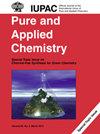反式-[PtX2(pic)2](Pic = γ-PICOLINE,X = Cl-,NO3-)与 N-乙酰基-l-半胱氨酸和谷胱甘肽的反应
IF 2
4区 化学
Q3 CHEMISTRY, MULTIDISCIPLINARY
引用次数: 0
摘要
反式-[PtX2(pic)2](pic = γ-甲基吡啶,X = Cl-,NO3-)与 N-乙酰-l-半胱氨酸(acSH)和谷胱甘肽(GSH)的反应受到 1H 和 195Pt NMR 的监测和跟踪。在反式-[Pt(pic)2(D2O)2](NO3)2 与 acSH 的反应中,在 195Pt NMR 光谱中观察到的最强峰是反式-[Pt(pic)2(acS)}2(µ-acS)]+ (3)。光谱中看不清楚的中间产物为反式-[Pt(pic)2(acS)(D2O)]+ (2),较弱的峰为反式-[Pt(pic)2(acS)2] (1)。对于 GSH,观察到的主要产物是反式-[Pt(pic)2(GS)2] (4),而中间产物在本研究中没有观察到。在反式-[PtCl2(pic)2]与 acSH 的反应中,除了形成配合物 1 和 3 外,核磁共振光谱中还观察到反式-[Pt(pic)2Cl(acS)] (6) 的形成,而当它与 GSH 反应时,与 acSH 反应的过程相似,但速度更慢。本文章由计算机程序翻译,如有差异,请以英文原文为准。
Reactions of trans-[PtX2(pic)2] (Pic = γ-PICOLINE, X = Cl−, NO3 −) with N-acetyl-l-cysteine and glutathione
The reactions of trans -[PtX2 (pic)2 ] (pic = γ-picoline, X = Cl− , NO3 − ) with N-acetyl-l -cysteine (acSH) and glutathione (GSH) were monitored and followed by 1 H and 195 Pt NMR. In the reaction of trans -[Pt(pic)2 (D2 O)2 ](NO3 )2 with acSH, in the 195 Pt NMR spectra, the most intense peak observed was trans -[Pt(pic)2 (acS)}2 (µ-acS)]+ (3). The intermediate product which was not clearly seen in the spectra was formulated as trans -[Pt (pic)2 (acS)(D2 O)]+ (2), with the weaker peak one as trans -[Pt(pic)2 (acS)2 ] (1). With GSH, the main product observed was trans -[Pt(pic)2 (GS)2 ] (4), while the intermediate product was not observed during this study. In the reactions of trans -[PtCl2 (pic)2 ] with acSH, besides complexes 1 and 3 formed, the formation of trans -[Pt(pic)2 Cl(acS)] (6) was also observed in the NMR spectra, while when it was reacted with GSH, followed a similar course to that of with acSH, but more slowly.
求助全文
通过发布文献求助,成功后即可免费获取论文全文。
去求助
来源期刊

Pure and Applied Chemistry
化学-化学综合
CiteScore
4.00
自引率
0.00%
发文量
60
审稿时长
3-8 weeks
期刊介绍:
Pure and Applied Chemistry is the official monthly Journal of IUPAC, with responsibility for publishing works arising from those international scientific events and projects that are sponsored and undertaken by the Union. The policy is to publish highly topical and credible works at the forefront of all aspects of pure and applied chemistry, and the attendant goal is to promote widespread acceptance of the Journal as an authoritative and indispensable holding in academic and institutional libraries.
 求助内容:
求助内容: 应助结果提醒方式:
应助结果提醒方式:


